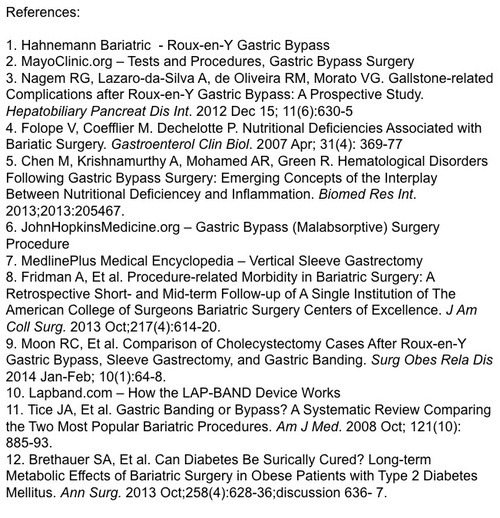Sage is here to help.
Feel like you could be eating better? Not sure what to change or where to look? Sage Nutritious Solutions make it easy for you to discover the wide, wonderful world of balanced, healthy, bangin' food.
RE: Gastric Bypass Surgeries
Obesity is an ever-growing epidemic in the United States (affecting over 50% of the population) that is also responsible for increased rates of type- II diabetes, cardiovascular diseases, and other health risks. Healthcare has focused its energy on "fixing obesity" through the help of bariatric specialists, who perform specific surgeries to kickstart rapid weight loss. The three most common gastric bypass surgeries include, Roux-en-Y, Laprascopic Sleeve Gastrectomy, and the adjustable Gastric Banding (Lap Band). Each procedure has beneficial applications as well as potential risks. Whether you are contemplating the surgery for yourself or know a loved one who may undergo gastric bypass, having a better understanding of the facts is essential to lifelong success.
Roux-en-Y is the most common form of gastric bypass and is ranked in the middle in terms of risks when compared to other bariatric surgeries (1). The surgeon creates a small pouch at the top of the stomach, completely disconnecting the remainder of the stomach and part of the small intestine, to reduce the volume of food that the stomach can carry and limiting the amount of calories the small intestine can absorb. The new, much smaller stomach is then attached to a different section of the small intestine. The disconnected lower stomach still produces gastric juices, which can flow to the small intestine even though it can no longer carry food (2). Many times this surgery must also entail the removal of the gallbladder because bypass vastly increases an individual’s risk for gallstones (3). Nutritional deficiencies are a concern, such as malabsorption of vitamins A, D, E, & K, folic acid, and zinc (4). Other concerns related to nutrition include loss of lean muscle due to reduced protein intake, chronic anemia due to poor iron levels, lack of vitamin B12 absorption, and copper deficiencies that compromise blood health (5). 85% of patients will experience "dumping syndrome" post-surgery with symptoms ranging from vomiting, diarrhea, nausea, light-headedness, and fainting (6)."
The Sleeve Gastrectomy removes a large portion of the patients’ stomach leaving behind a portion of the stomach about the shape and size of a banana. Absorption of nutrients is not affected by this procedure but rather reduces the amount of food an individual can consume (2). The Sleeve has been increasingly recommended as a method of weight loss surgery, though a second surgery may be needed later on. Patients should expect to see slower weight loss with the sleeve gastrectomy compared to roux-en-y bypass surgery (7). While the Sleeve is without the severity of the risks that are associated with Roux-en-Y, it still poses a danger for the development of nutritional deficiencies, and "dumping syndrome" similar to Roux-en-Y, however these risks are not nearly as high (8). Gallstone formation is just as much of a risk and therefore gallbladder removal is still strongly recommended in coordination with the Sleeve (9).
The Lap Band is the least invasive of the procedures as it requires no staples or any removal of the gastrointestinal tract and is also reversible. A band with an inflatable balloon is placed around the top of the stomach to create a small pouch with a very narrow entry to the rest of the stomach. The lap band reduces the amount of food one’s stomach can hold in order to feel fuller after eating less food (2). Band slippage and erosion or deflation of the balloon are risks that may require additional operations (10). The Lap Band has significantly lower risks for the development of nutritional deficiencies, gallstone formations, and "dumping syndrome" versus other gastric bypass surgeries, however, it has the highest reoperation rates and is less successful at establishing weight loss (11).
People often consider gastric bypass to be a "cure" for obesity. There is much more to it than a scalpel, a slice, and sutures. Most healthcare groups stress the importance of a multidisciplinary approach to weight loss, incorporating holistic as well as medical strategies. This is due to the amount of turmoil associated with any weight loss procedure. Dietary compliance is difficult to maintain because of the lack of nutrition education patients usually receive. The effects of nutritional deficiencies can be daunting, so it is important for the patient to eat enough protein or take a supplement, receive vitamin B12 injections, and consume a varied diet rich in iron and other nutrients. Because this is difficult to reach and maintain with limited amounts of food, supplements are common. Support from medical staff, loved ones, and other healthcare professionals can vary, leaving the patient feeling alone and vulnerable to the multitude of food ads that flood the media.
The decision to undergo such a procedure should not be taken lightly. While gastric bypass may be an excellent answer to rectify morbid obesity in individuals who are unable to successfully lose weight with diet and exercise (12) - a plethora of risks are associated with bariatric surgery and often times require a second operation. At The Sage, we strive to promote good nutrition and regular physical activity as preventive care and to help as many people as possible to maintain optimal health. Should a person find himself or herself faced with gastric bypass as a last resort, we highly recommend that they include a well qualified team of physicians, dieticians, and other healthcare professionals to help minimize complications, regaining weight, nutrient deficiencies, and to reach a healthier lifestyle.

Happy Eating and Living!
Alexandria Wolz, Cooperative Intern for:
